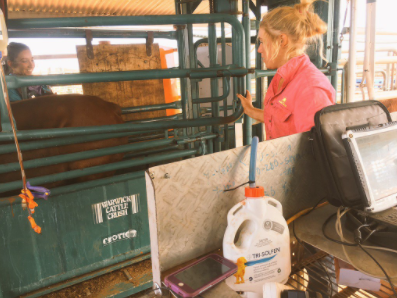Pain relief trialled in the Pilbara

Theme: Animal welfare
Priority: Animal husbandry techniques
Producer: Annabelle Coppin
Location: Yarrie Station, WA
“A practical, effective and efficient pain relief for our husbandry practices is not only vital for the future of our industry, it should lift our production, decrease mortality and make this practice easier to carry out”
KEY POINTS
- Annabelle Coppin trialled a new pain relief spray trialled on castrated calves
- The numbing spray was practical, easy to use and effective and providing pain relief
- The spray was promising as a means to improve animal welfare outcomes and meet consumer expectations
When a practical pain relief method came onto the market for Australian beef producers, Annabelle Coppin was keen to try it.
Annabelle trialled the new pain relief spray on the family’s Yarrie Station in the East Pilbara region of Western Australia.
Annabelle owns and manages the property, which has been in the Coppin family for five generations. She and her team run cattle over two properties (one on the Pilbara and one in the mid-west of WA) that span 250,000 hectares (617,700) acres. Last year, Annabelle used an anaesthetic spray when she and her team castrated calves.
“We’d been waiting a long time for a pain relief product that was efficient to use and that works,” Annabelle said.
She said previously the only pain relief option was getting a veterinarian to come out and inject the cattle, which is not possible, especially for a remote station such as Yarrie.
Annabelle found the numbing spray was promising (not yet proven). She said it was easy to spray on, although it was difficult to measure. She plans to use it again this year and keep observing the benefits. She supports Meat & Livestock Australia (MLA), the producer-owned company that provides marketing and research and development services for the red meat and livestock industry, in doing more trials into pain relief options.
“A practical, effective and efficient pain relief for our husbandry practices is not only vital for the future of our industry, should lift our production, decrease mortality and make this practice easier to carry out,” Annabelle said.
“We need to be proactive in the industry,” she said, adding meeting consumers’ expectations (including about animal welfare) was paramount for the beef industry’s sustainability.
The Australian Beef Sustainability Framework’s Consultative Committee chose animal husbandry techniques as a priority area for focus, and one of its indicators is the percentage of the Australian cattle herd using pain relief regularly for husbandry practices.
“And the pain relief needs to work for producers, so it’s not only a feel-good story.”
Using pain relief is not the only animal welfare measure that the Coppin family and their employees undertake. Other measures include Annabelle running a week-long course to teach their staff to best handle young cattle when they are first brought into the years. She said the course, which was developed with a livestock consultant Boyd Holden, helps handlers develop a positive relationship with the young cattle, which makes future handling easier and safer throughout their lives on the station and beyond.
“Quiet cattle are less stressed in any situation, whether it be on property, on trucks, in a feedlot, abattoir or on a ship,” Annabelle said.
Categories: Animal welfare